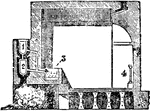Clipart tagged: ‘baths’

Balneum
"Balneum or balineum signifies, in its primary sense, a bath or bathing vessel, such as most Romans…

Balneum
"Balneum or balineum signifies, in its primary sense, a bath or bathing vessel, such as most Romans…

Ancient Roman Baths
Bathing was an important part in Ancient Roman culture and society. In Germany there are These Roman…

Hall in Baths of Caracalla
"Marcus Aurelius Antoninus Caracalla was eldest son of the Emperor Severus, born in Lyons, A.D. 188.…

Ruins of the Baths of Caracalla
The ruins of the baths of Caracalla were roman public baths built in Rome, Italy between AD 212 and…

Farnese Hercules
"The Farnese Hercules (Colossal). Found in 1540 in the Baths of Caracalla. In the Naples Museum." —D'Anvers,…

Roman Baths
"The baths of Titus, the name of each part of the building is inscribed on it. The small dome inscribed…

Tusculum Bath
"Section of the Bath discovered at Tusculum, showing the calidarium (hot room)." — Encyclopedia…
